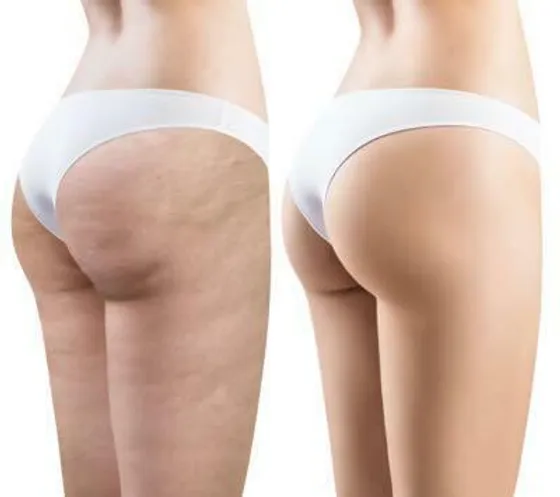Did you know that nearly ninety percent of women over age 20 (and less than five percent of men) experience cellulite? In this article I’ll tell you what I’ve learned about cellulite and the best ways to treat it.
What is cellulite? Cellulite has that dimpled, lumpy skin appearance much like an orange peel, usually of the thighs and buttocks of women over age 20. Let’s consider briefly the what skin structures are at work here.
You have three fat layers below the skin of your thighs and buttocks: subcutaneous fat, a.k.a. the hypodermis: this fat is 4-6 mm deep, just below the dermis layer of skin. This fat will protrude through an open wound or laceration. It is regulated by hormones, not diet and exercise. Here is where cellulite originates. superficial reserve fat: this is a tightly packed layer of fat just below the hypodermis deep reserve fat: this is loosely packed fat, and is easy to lose with exercise
Cellulite forms as pockets of fat in the hypodermis become surrounded by connective tissue bands, called septae. These septae are rigid collagen cross-links, arranged into chambers, which give the undesirable appearance of cellulite, and they are not something you can just diet-away.
In fact, cellulite is not more prevalent in obese people—cellulite actually tends to be less prominent in overweight and obese people because their extra deep reserve fat layer supports and smooths any cellulite layer above it.
As water is retained, fat cells enlarge, which causes the fat chambers to expand against the non-flexible septal bands. Then there is decreased lymphatic drainage and decreased venous flow due to inelasticity of the chambers. The swelling in these chambers, along with protein deposits over time that further harden this septae, worsen the dimpled appearance as the tighter connective tissue bands pull down on the dermal skin layer.
Grade 1 cellulite (dimpling only seen when skin is pinched), grade 2 cellulite (dimpling seen when standing but disappears when lying down, and grade 3 cellulite (dimpling seen even when lying down) can all respond to treatment as outlined below. Nodular cellulite (grade 4), however, has no effective treatment that I know of.
What contributes to cellulite? Although we can attribute most of the cause to a genetic predisposition, there are lifestyle and hormonal factors that play a role: Poor diet chronically (contributor to inflammation in all body tissues) Smoking (decreased oxygenation of fat layer) Lack of exercise (promotes congestion of cellular metabolism byproducts) Predisposition to superficial venous insufficiency (lack of blood return from fat) Multiple pregnancies (hormonal changes and venous insufficiency)
Two best treatments for cellulite There are several treatments for cellulite that have limited or no long-term effectiveness. However, these can be used to help the two best treatments (I’ll describe below) work better. They include creams (containing some of the mesotherapy ingredients discussed below), lymphatic massage, wraps (with seaweed, aloe vera, clay), mechanical cell stimulation (endermologie), and cryotherapy.
Mesotherapy One of the two best treatments for cellulite is mesotherapy injections. The solution contains ingredients to break down fat and help metabolize it: Hyaluronidase: a naturally-occurring enzyme that breaks down hyaluronic acid Caffeine or Aminophylline: activates fat-burning effect Pentoxifylline: Decreases blood thickness to improve peripheral blood flow L-carnitine: an amino acid that shuttles fat into the mitochondria for processing Melilotus: improves lymphatic drainage, converts naturally to a blood thinner Lidocaine for local anesthesia
The traditional treatment course requires 200 – 500 injections per thigh, placed 4 mm deep, done weekly, for 10-15 weeks. You can expect no more than a 1-grade improvement with a treatment course. Maintenance treatment is done every 2-6 weeks.
Newer treatments are to use microneedling to inject Platelet Rich Plasma (autologous platelets containing concentrated growth factors to stimulate new healthy tissue growth) 1-2 mm deep.
Radio Frequency (RF) RF energy It is a type of electromagnetic radiation with longer wavelengths, lower frequencies, and lower energy levels than ionizing radiation, and therefore is safe. It heats body tissues below the skin (in the hypodermis) to increase blood microcirculation and metabolism, with a subsequent natural lipolysis and shrinking of the fat cells.
There are numerous companies who have perfected this technology. Some add Infrared radiation to the RF energy.
In my office we use multi-Radio Frequency channels with vacuum suction (stretch-relaxation model) by Viora (www.vioramed.com) to help reduce cellulite to give firmer and tighter skin. Vacuum action enhances lymphatic drainage (waste removal, reduces intracellular edema), gives a deeper depth of penetration of RF energy, improves local blood circulation, and improves elasticity of the connective tissue by mechanical stretching.
To long-term health and feeling good,









